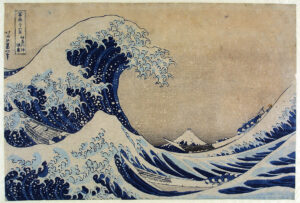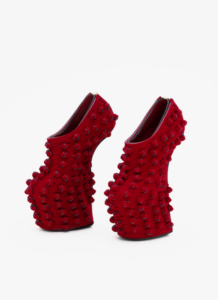At the Frist
Myths to Manga
On Thursday, October 24th, I was able to attend the opening of Journey Through Japan: Myths to Manga at the Frist Art Museum. It is divided into four main sections: Sky, Sea, Forest, and City. Each section shows how folk tales or myths have shaped art and culture in Japan. The exhibition presents over 150 historic and contemporary objects, ranging from animated movies, origami, and ukiyo-e woodblock prints to dolls, robots, and youth fashion. This exhibit was created to be family friendly and there are lots of fun things for children of all ages to enjoy; there’s an origami station, books, taiko drums, and supplies to make your own manga comic.

by Katsushika Hokusai (1760 – 1849);
Japanese; 19th century.
Woodblock print.
In the first section, Sky, one of the folk stories is about the moon. Similar to the way Americans might say the moon is made of cheese, the Japanese talk about the rabbit that lives on the moon. According to folklore, the ruler of heaven visits earth disguised as a beggar and asks three animals to help him. When he gets to the rabbit, who has nothing to share, the rabbit offers up himself as food. To honor the rabbit, he is elevated to the moon. The moon is still found in popular tales today, like Sailor Moon: a manga about five schoolgirls who use their super powers to defend the solar system.
The second section, Sea, has a print of one of the most well-known works of Katsushika Hokusai, Under the Wave off Kanagawa or The Great Wave. There is also a woodblock print from an unidentified artist entitled The monster catfish causing chaos. In Japanese myths, a giant catfish, Namazu, causes earthquakes and tsunamis by thrashing his tail. Today, an image of a catfish has been used for disaster prevention mascots.

The third section, Forest, tells us stories of humans interacting with wildlife and the need to live in harmony with nature. In the fable of the tongue-cut sparrow, a kind woodcutter befriends a hurt sparrow. One day, the sparrow mistakenly eats the woodcutter’s wife’s laundry starch, so he cuts out his tongue. The woodcutter is worried about the sparrow and goes searching for him in the forest. When he finds him, the sparrow is touched by his kindness and offers him the choice between a small box and a large box. He chooses the small box and it’s full of treasure. His greedy wife goes to find the sparrow and take the large box which turns out to be full of demons or serpents depending on which version of the tale you hear. The exhibit shows clips from Studio Ghibli films: My Neighbor Totoro and The Tale of the Princess Kaguya. My Neighbor Totoro explores the relationship between two young girls and a large forest spirit. They are kind to him and he helps them in return. The Tale of the Princess Kaguya is an adaptation of “The Tale of the Bamboo Cutter,” a 10th-century Japanese tale. A bamboo cutter finds a girl in a bamboo shoot and later finds gold and fine cloth. Believing her to be divine royalty, he raises her and forces her to act like a noble. It is later revealed that she was once a resident on the moon who wanted to experience mortal life. The film ends with her going back to the moon. In these movies we are shown the sacred quality of nature and celestial beings.
In the final section, City, there is an emphasis on the contrast between old and new. In cities like Kyoto, Osaka, and Tokyo, old family homes sit alongside new skyscrapers. According to Japanese folklore, Yōkai (shape-shifting, supernatural beings that include creatures, demons, and spirits) come out at night to cause mischief and mayhem. They can be friendly and playful but they can also be cruel, so it’s best to stay on your guard! These spirits inspire anime, videos games and even fashion accessories. Perhaps the most well known example is Pokémon. Pokémon is a Japanese media franchise consisting of video games, animated series and films, a trading card game, and most recently, the smart phone game: Pokémon Go.
The exhibit will be in the upper galleries until February 16th, 2025. There is a lot more to experience, so bring the whole family and check it out!



